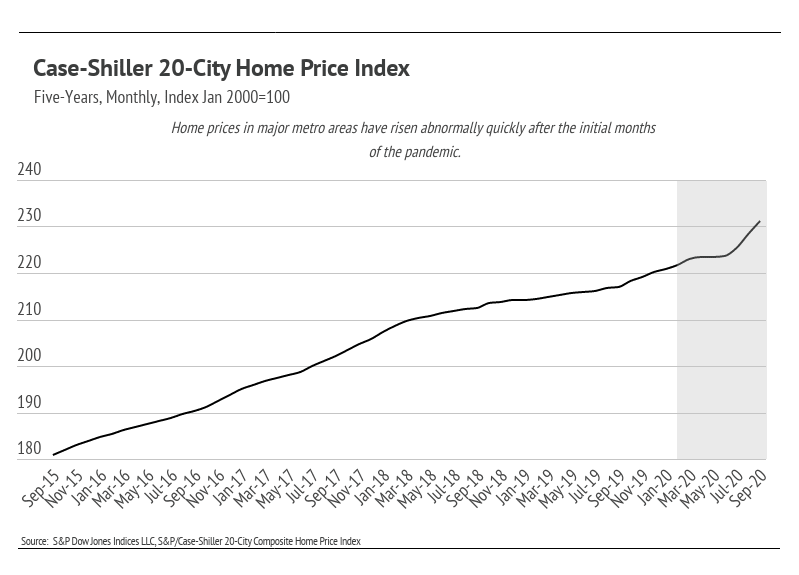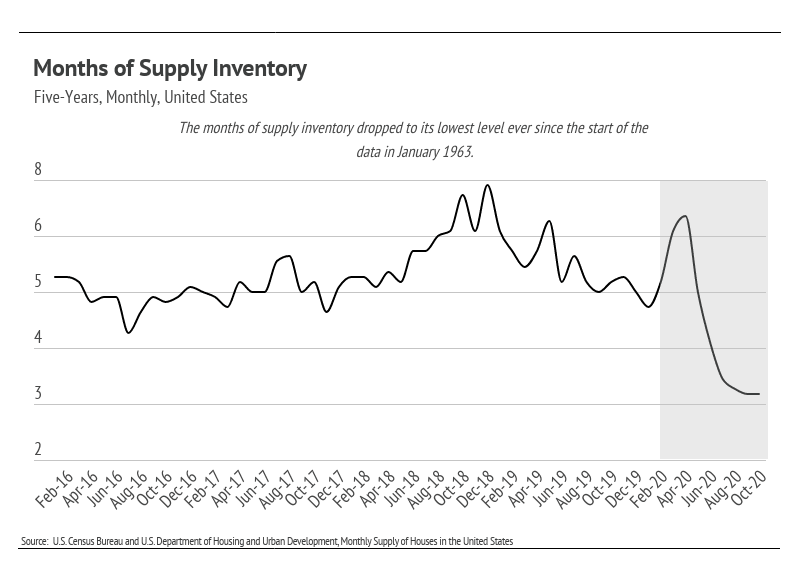December Newsletter – Key Topics and Trends


As we enter the final month of 2020, demand remains significantly high. Typically, the majority (55% to 70%) of American homebuyers are also home sellers, swapping their previous homes for something better suited to their changing needs. The current increase in price and decrease in supply, however, imply that more first-time homebuyers are entering the markets (a record-setting 2+ million first-time buyers), and more existing homeowners are buying second homes. For years, the amount of available housing has not kept up with demand, but the new wave of buyers has highlighted just how considerable the housing shortage is in the United States.
The Case-Shiller 20-City Home Price Index measures, in aggregate, the cost of a home across 20 major U.S. cities. It also serves as a barometer for the overall health of the economy. As we can see in the chart below, home prices have moved significantly higher over a short period of time, reaching record highs.

We can couple the price information with the Months of Supply Inventory (MSI), which quantifies the relationship between supply and demand. More specifically, MSI refers to the number of months it would take for the current inventory of homes on the market to sell given the current sales pace. Historically, six months of supply is associated with moderate price appreciation, and a lower MSI tends to push prices up more rapidly, according to the National Association of Realtors. At a national level, the supply of homes relative to demand is the lowest it has ever been since the data were first tracked in 1963. Because of technological advances, virtual tours, and faster document processing, homes can be sold quickly, thereby reducing the supply of homes for sale at a much faster rate.
The current situation creates a feedback loop that drives prices higher. The most desirable benefit, especially when there are three to four offers on a property, is that the property will be sold for the highest possible price. That home then becomes a comparable property for other homes nearby, driving up prices in the neighborhood when they, in turn, go on the market.

President-elect Joe Biden released a $640 billion housing plan, part of which aims to make homeownership more accessible to mid- and low-income Americans. Some ideas in the plan include giving a tax credit up to $15,000 at the time of purchase and offering down payment assistance to teachers, first responders, and other essential service workers. Although this will certainly help some people, the most desirable properties will likely remain within reach only for upper-income earners. Additionally, if new affordable housing is not built, prices could rise for the currently more affordable homes. We will keep an eye on the implementation of these policies to gauge their efficacy.
Demand shows no sign of decline in the near term. Today, housing is one of the best investments one can make, as it has been historically.
Stay up to date on the latest real estate trends.






You’ve got questions and we can’t wait to answer them.